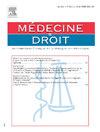À propos du diagnostic préimplantatoire des aneuploïdies (DPI-A). Les inconvénients de mots inappropriés et d’une réglementation inadaptée
IF 0.1
Q4 MEDICINE, LEGAL
引用次数: 0
Abstract
Finding biological markers to assess the ability of embryos to develop is a major objective of research being carried out to improve the results of in vitro fertilization (IVF). Among these markers, the chromosomal content of embryonic cells has been the subject of numerous studies to identify euploid embryos which will be transferred as a priority into the uterus. In France, a clinical research program funded by the Ministry of Health was undertaken to evaluate the benefit of this strategy when IVF is carried out in women aged 35 to 41. This program was interrupted because its authorization was canceled by a court on the grounds that the search for aneuploidy in the embryo is a preimplantation genetic diagnosis (PGD) and that this type of analysis is not provided for in the governing law. The law says in fact that a PGD can only be carried out if “has been previously and precisely identified, in one of the parents or one of their immediate ascendants in the case of a seriously disabling illness, with late revelation and prematurely endangering the vital prognosis”. But the chromosomal analysis provided for in the research protocol is not a diagnosis, it is a test which identifies the embryos most capable of developing. Like all other techniques with the same goal, this test is not the responsibility of the law but of the good practice guide. Studies seeking to improve the results of IVF for the benefit of couples who use it should not be prevented.
非整倍体植入前诊断(PGD-A)。用词不当和规定不合适的弊端
寻找评估胚胎发育能力的生物标记物是提高体外受精(IVF)效果的一项主要研究目标。在这些标志物中,胚胎细胞的染色体含量一直是众多研究的主题,目的是确定优先移植到子宫中的优倍体胚胎。在法国,卫生部资助了一项临床研究计划,以评估 35 至 41 岁女性在进行体外受精时采用这一策略的益处。这项计划被中断了,因为法院取消了对它的授权,理由是在胚胎中寻找非整倍体属于胚胎植入前遗传学诊断(PGD),而这种分析在相关法律中没有规定。事实上,法律规定,只有 "在父母一方或其直系尊亲属患有严重致残性疾病,并在晚期才显现出来,过早地危及重要预后的情况下,先前已被准确鉴定",才能进行胚胎植入前遗传学诊断(PGD)。但是,研究方案中规定的染色体分析并不是诊断,而是确定最有能力发育的胚胎的试验。与所有其他具有相同目标的技术一样,这种检测不是法律的责任,而是良好操作指南的责任。不应阻止为使用体外受精的夫妇的利益而改进体外受精结果的研究。
本文章由计算机程序翻译,如有差异,请以英文原文为准。
求助全文
约1分钟内获得全文
求助全文
来源期刊

Medecine & Droit
MEDICINE, LEGAL-
CiteScore
0.30
自引率
0.00%
发文量
27
期刊介绍:
The Scientific Committee of the journal Médecine et Droit includes professors of medicine, professors of law, magistrates, lawyers, court medical experts, and specialists in compensation for physical injury. Médecine et Droit provides: • rigorous and clear support for informative and educational matter • a tool for reflection and actualisation of knowledge • an essential link between doctors and lawyers. Médecine et Droit informs: • doctors on different aspects of law and regulations encountered in their profession • lawyers on the specific problems of the medical profession and important bio-ethical issues
 求助内容:
求助内容: 应助结果提醒方式:
应助结果提醒方式:


